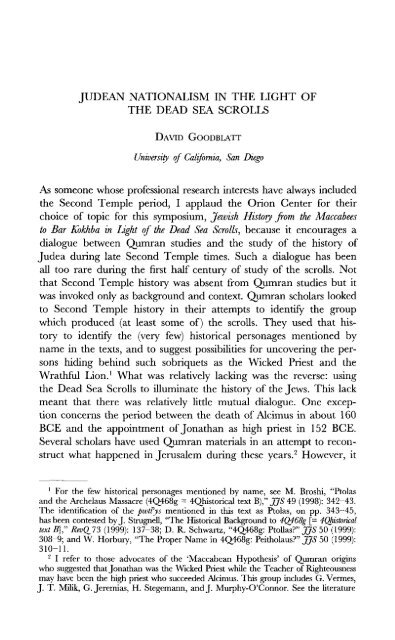historical perspectives: from the hasmoneans to bar kokhba in light ...
historical perspectives: from the hasmoneans to bar kokhba in light ...
historical perspectives: from the hasmoneans to bar kokhba in light ...
Create successful ePaper yourself
Turn your PDF publications into a flip-book with our unique Google optimized e-Paper software.
JUDEAN NATIONALISM IN THE LIGHT OF<br />
THE DEAD SEA SCROLLS<br />
DAVID GOODBLATT<br />
University of California, San Diego<br />
As someone whose professional research <strong>in</strong>terests have always <strong>in</strong>cluded<br />
<strong>the</strong> Second Temple period, I applaud <strong>the</strong> Orion Center for <strong>the</strong>ir<br />
choice of <strong>to</strong>pic for this symposium, Jewish His<strong>to</strong>ry <strong>from</strong> <strong>the</strong> Maccabees<br />
<strong>to</strong> Bar Kokhba <strong>in</strong> Light of <strong>the</strong> Dead Sea Scrolls, because it encourages a<br />
dialogue between Qumran studies and <strong>the</strong> study of <strong>the</strong> his<strong>to</strong>ry of<br />
Judea dur<strong>in</strong>g late Second Temple times. Such a dialogue has been<br />
all <strong>to</strong>o rare dur<strong>in</strong>g <strong>the</strong> first half century of study of <strong>the</strong> scrolls. Not<br />
that Second Temple his<strong>to</strong>ry was absent <strong>from</strong> Qumran studies but it<br />
was <strong>in</strong>voked only as background and context. Qumran scholars looked<br />
<strong>to</strong> Second Temple his<strong>to</strong>ry <strong>in</strong> <strong>the</strong>ir attempts <strong>to</strong> identify <strong>the</strong> group<br />
which produced (at least some of) <strong>the</strong> scrolls. They used that his<strong>to</strong>ry<br />
<strong>to</strong> identify <strong>the</strong> (very few) <strong>his<strong>to</strong>rical</strong> personages mentioned by<br />
name <strong>in</strong> <strong>the</strong> texts, and <strong>to</strong> suggest possibilities for uncover<strong>in</strong>g <strong>the</strong> persons<br />
hid<strong>in</strong>g beh<strong>in</strong>d such sobriquets as <strong>the</strong> Wicked Priest and <strong>the</strong><br />
Wrathful Lion. 1 What was relatively lack<strong>in</strong>g was <strong>the</strong> reverse: us<strong>in</strong>g<br />
<strong>the</strong> Dead Sea Scrolls <strong>to</strong> illum<strong>in</strong>ate <strong>the</strong> his<strong>to</strong>ry of <strong>the</strong> Jews. This lack<br />
meant that <strong>the</strong>re was relatively little mutual dialogue. One exception<br />
concerns <strong>the</strong> period between <strong>the</strong> death of Alcimus <strong>in</strong> about 160<br />
BCE and <strong>the</strong> appo<strong>in</strong>tment of Jonathan as high priest <strong>in</strong> 152 BCE.<br />
Several scholars have used Qumran materials <strong>in</strong> an attempt <strong>to</strong> reconstruct<br />
what happened <strong>in</strong> Jerusalem dur<strong>in</strong>g <strong>the</strong>se years. 2 However, it<br />
1 For <strong>the</strong> few <strong>his<strong>to</strong>rical</strong> personages mentioned by name, see M. Broshi, "P<strong>to</strong>las<br />
and <strong>the</strong> Archelaus Massacre (4Q468g = 4Q<strong>his<strong>to</strong>rical</strong> text B)," JJS 49 (1998): 342-43.<br />
The identification of <strong>the</strong> pwt ys mentioned <strong>in</strong> this text as P<strong>to</strong>las, on pp. 343—45,<br />
has been contested by J. Strugnell, "The His<strong>to</strong>rical Background <strong>to</strong> 4Q468g [= 4Q<strong>his<strong>to</strong>rical</strong><br />
text B]," RevQ73 (1999): 137-38; D. R. Schwartz, "4Q468g: P<strong>to</strong>llas?" JJS 50 (1999):<br />
308-9; and W. Horbury, "The Proper Name <strong>in</strong> 4Q468g: Peitholaus?" JJS 50 (1999):<br />
310-11.<br />
2 I refer <strong>to</strong> those advocates of <strong>the</strong> 'Maccabean Hypo<strong>the</strong>sis' of Qumran orig<strong>in</strong>s<br />
who suggested that Jonathan was <strong>the</strong> Wicked Priest while <strong>the</strong> Teacher of Righteousness<br />
may have been <strong>the</strong> high priest who succeeded Alcimus. This group <strong>in</strong>cludes G. Vermes,<br />
J. T. Milik, G. Jeremias, H. Stegemann, and J. Murphy-O'Connor. See <strong>the</strong> literature

















